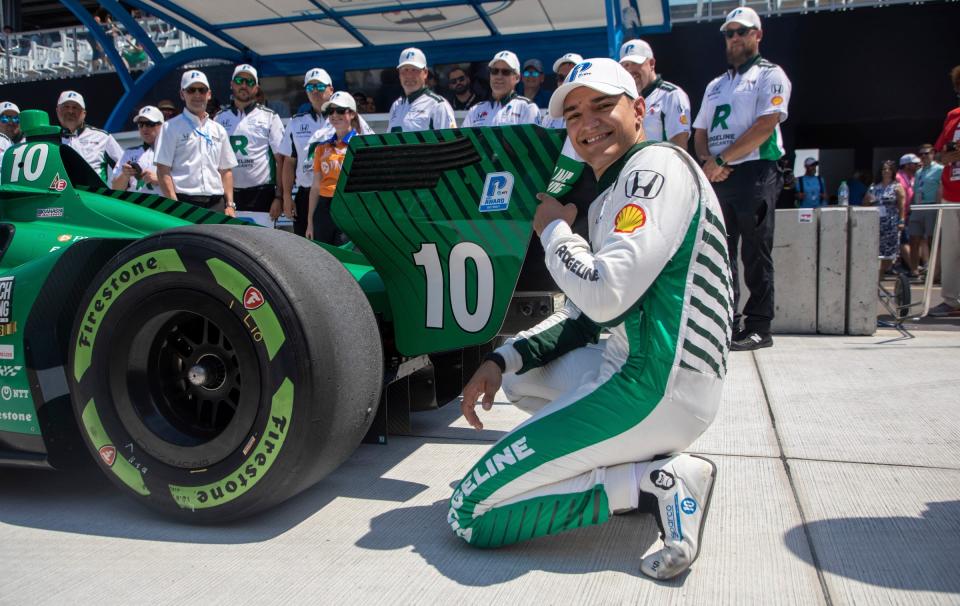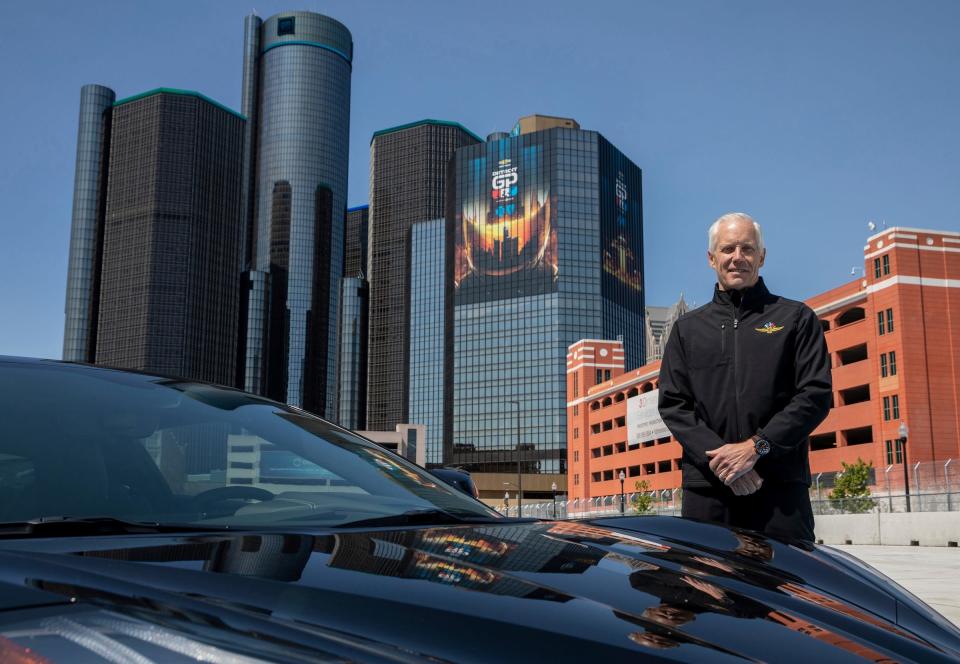'Better than expected': IndyCar, drivers evaluate Detroit street course after first race
DETROIT – Penske Corp. president Bud Denker was waiting anxiously for the numbers to roll in, as he sat inconspicuously off to the side of Alex Palou’s winner’s news conference. The same driver in the same seat just over 24 hours ago had called the new racecourse Denker spearheaded as part of a transformation of the Detroit Grand Prix “too tight,” “too short,” “too bumpy” with “too much traffic” for IndyCar’s 27-car grid.
The Chip Ganassi Racing driver turned his second-consecutive pole into his second win in three races, sixth of this career and first on a street course. Palou was by no means the only one inside the IndyCar paddock to feel those sentiments after Saturday morning’s second practice on the 1.645-mile track, though he was the only one who attached his name to it. So after Palou said the track ”was a lot better than I expected,” Denker made sure to set the record straight.
IndyCar: Alex Palou wins Detroit pole, then sounds off on 'too tight, too short' track
IndyCar results: Alex Palou wins Detroit Grand Prix, extends points lead
Sunday’s race saw 32 laps under caution – significantly less than the two iterations of Nashville’s new street race (both over 40%) that it was constantly compared to – and 189 on-track passes, 142 for position. The former number, Denker would have you know, equaled Long Beach, “And Long Beach had a hell of a race this year, right?”

The season-opener at St. Pete, also a 100-lapper with slightly more overall mileage (180 vs. 164.5), saw 170 on-track passes (vs. Detroit’s 189), 128 for position (compared to 142).
“Pretty good race,” said Denker, ending his monologue. His sly grin said far more.
That sentiment was shared, generally, from those IndyStar spoke with in the paddock post-race.
“It raced better than expected,” Arrow McLaren team boss Gavin Ward told IndyStar. “And because of that, there was less desperation. Those last couple laps? That was good, hard racing, and that’s what we’re all about, right? It wasn’t desperation stuff that I think we see in Nashville frequently.”
Of Sunday’s seven cautions, only one was strictly do to the track. On Lap 2, Callum Ilott was running on the outside of the 0.9-mile straight headed toward Turn 3 where the restart zone was. The Juncos Hollinger Racing driver didn’t brake soon enough and ran square into the back of Kyle Kirkwood, demolishing his rear wing.
Among the other carnage, Pato O’Ward crashed trying to will himself ahead of Palou, the race leader at the time who was trying to put O’Ward a lap down after the Arrow McLaren driver’s bungled pitstop. “I was boxed in on what I could do. It was either my race was over, or try and get past, and maybe my race was over,” O’Ward said. “It is what it is.”
A desperation move? Of course, but seemingly not one born out of a problematic track.

Twice, Sting Ray Robb went long into the Turn 3 runoff on a restart, couldn’t get himself spun back and stalled. The short, too narrow runoff areas were an issue. Denker said post-race the track, specifically in Turn 8, has the capability to widen by a few feet, but generally speaking said he felt they had proper profiles.
Two single-car incidents – Romain Grosjean hugging the Turn 4 apex wall too closely before making contact that spit him into the outside wall and ended his day and David Malukas crashing in Turn 9 headed toward the Lap 87 restart — but those mental mistakes can happen any time a driver goes past the limit of a track.
“It felt like there was some decent racing going on out there. I think it’s rough and tight and twisty … but I thought the potential for more chaos was definitely there, and most of us behaved pretty good out there,” said Marcus Ericsson, second in points after finishing 9th.
The race wasn’t without its intense moments. Grosjean tore out of the pits, cutting off Scott McLaughlin’s run toward Turn 1, despite cold tires – a move McLaughlin said post-race “destroyed” his day. In the Lap 91 restart following Malukas’s crash, Scott Dixon broke too deep and ran into the back of eventual runner-up Will Power, knocking the No. 12 Chevy car’s left wheels off the ground. That mess allowed Alexander Rossi to pounce quickly from 5th to 2nd and then saw Power take revenge with a hip-check on Dixon heading toward Turn 5.
And on Lap 97, Rossi and Felix Rosenqvist battled for the final spot on the podium, with Rossi squeezing his Arrow McLaren teammate through the Turn 3 hairpin, and then Rosenqvist jostling Rossi into the outer wall, allowing Dixon to squeeze by and finish 4th.
“It was cleaner than expected, but (Sunday’s race) also had the potential to be a lot worse,” Kirkwood said. “People were racing a little bit too hard for how tight the walls were. And you have a lot of ‘accordion effects’ here, where when one person passes, there’s a massive slowdown, and it’s so inviting then to make lunges and more passes on people on corners where two-wide doesn’t really work. There was a multitude of times where people would pass into Turn 4 and then travel side-by-side down into Turn 5, and passing into 5 just doesn’t really work.
“But you know what? I think it went as good as I think its first year could’ve gone.”
Denker said distance can’t be added to better accommodate IndyCar’s full-time field. Other street courses with similar distances (St. Pete and Toronto in particular) either offer more grip or are generally wider throughout the raciest parts of the track, making Detroit almost feel even shorter than the numbers say, according to drivers.
“I think it could be about 10 seconds longer per lap,” said Meyer Shank Racing owner Mike Shank. “It’s just too argy bargy, in my opinion, through Turns 3-4-5. It’s just a scrum, a terrible scrum.
“I love it. I love it, and there’s many positives to take away. I just think we need to work on the course, in my humble opinion, a little bit.”
Among Shank’s wishes were to incorporate the Detroit Riverfront a bit more, which Denker said was the original plan, using more of Atwater Street (which on the current course included the run between Turns 7 and 8). But that course was too rectangular. Adding length to the east brings it into neighborhoods. West butts into the tunnel. And north encroaches on businesses, which was a nonstarter for a race promoter that proudly said Sunday it did not force a single business to close during the weekend.
The most common complaint post-race was the inability to take advantage of the long straight between Turns 2 and 3 that matches the length of the two straightaways at the 2.5-mile Indianapolis Motor Speedway. At nearly 0.9 miles, ideally drivers would be able to suck up close and attempt passes even mid-straight.
But drivers uniformly said the outside line was far too bumpy; midway through the race rubber marbles off cars’ tires blanketed all but one swath of that section.
“The whole straightaway, in my opinion, they should repave,” Ericsson said. “The rest of the bumps around the track is the character of the track, and you get the hang of it, so I don’t really mind that. But the straight, it takes away from the racing because it’s so bumpy.”
That straight on Jefferson Avenue, however, includes at least 10 intersections with a small amount of mounding to help with drainage. The section of road operated by the state of Michigan in all likelihood can’t just be repaved and flattened to be pool table-smooth because of that, according to Denker, so some other fix will have to be found.
Denker was a bit taken aback post-race, because the only feedback received from drivers testing the track on their simulators was that the right side of the braking zone needed to be ground down. So Denker didn’t know why drivers almost uniformly hugged the left side of the track while headed for the hairpin. That 100 feet of track had been properly treated but the half-mile before it wasn’t a competitive line.
That, like so many things, couldn’t be discovered on a computer simulation or from driving over it in a street car.
“I think a lot of people thought it was going to be a bit chaotic, but it was a really good race,” said Chip Ganassi Racing team manager Taylor Kiel. “I think it’s easy to point out the faults in something like this, but I think the Detroit GP team will do a deep-dive into what could be better and what was good, and ultimately, you can back on the fact that when we’ll be back next year, it’s going to be an event better event.
“The circuit presents different challenges and we just have to figure out how to overcome them. That’s what we do in motorsports, and what we do in this team is try and figure out how to overcome challenges better than everyone else.”
This article originally appeared on Indianapolis Star: IndyCar, drivers evaluate Detroit street course after first race
